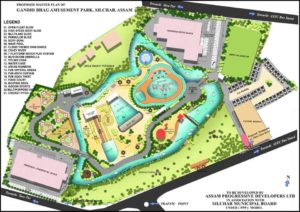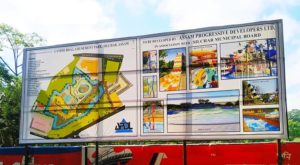Barak UpdatesAnalyticsBreaking News
Gandhi Bagh: Ecosystem and development, conflict of interest, writes Dr. Sobhan Dutta Gupta

December 2: Urbanization of Silchar truly started in the last part of 19th century by upgradation of Silchar town committee to Silchar Municipal Board. However, curiously, the nature of Silchar town has always been that of a small town or big village acting like a city. In Silchar, population increased with tendency of geometric progression due to influx of people from mainland India since 1862. Influx of people has taken a uncontrollable shape after 1947 and during wide range of agitation against the Bengalis in Bhramaputra Valley, Meghalaya, Nagaland and Mizoram during the decades of 70s to 80s. This uncontrolled influx of people in this small town resulted in loss of its carrying capacity as an urban ecosystem. The situation worsened due to unplanned policy-making activity or lack of motivation of the guardians who were at the helm of Silchar Municipal Board. The main approach and commitment of civic committee towards the citizens of Silchar to ensure quality of life has been compromised by its own Municipility Board.
 The latest addition to this depletion in Silchar is due to the faulty stand adopted by its Municipal Board headed by its Chairman Niharendra Naryan Thakur. He has devoted himself in leasing the man-made ecosystem and free space in Silchar town popularly known as Gandhi Bag and its adjoining area to a private construction company. It will not be out of context to mention that, this man-made ecosystem was established in the early decades of 20th century by the then Chairman of Silchar Municipality Board, Kamini Kumar Chanda and other eminent citizens of Silchar, with a motive to establish the ecosystem which will work as breathing house and oxygen generator of this expanding urban ecosystem.
The latest addition to this depletion in Silchar is due to the faulty stand adopted by its Municipal Board headed by its Chairman Niharendra Naryan Thakur. He has devoted himself in leasing the man-made ecosystem and free space in Silchar town popularly known as Gandhi Bag and its adjoining area to a private construction company. It will not be out of context to mention that, this man-made ecosystem was established in the early decades of 20th century by the then Chairman of Silchar Municipality Board, Kamini Kumar Chanda and other eminent citizens of Silchar, with a motive to establish the ecosystem which will work as breathing house and oxygen generator of this expanding urban ecosystem.
 It needs mention that most of the saplings planted at Gandhi Bagh were then brought from Acharya Jagadish Chandra Bose Indian Botanic Garden, Kolkata (earlier known as Royal Botanical Garden, Kolkata) for plantation and a beautiful aquatic ecosystem popularly known as ‘Sapnala’was developed for maintenance of soil aquatic balance of the system. In the course of time, Gandhi bag and its adjoining area including ‘Sapnala’ has become a signature of heritage in this century old town.
It needs mention that most of the saplings planted at Gandhi Bagh were then brought from Acharya Jagadish Chandra Bose Indian Botanic Garden, Kolkata (earlier known as Royal Botanical Garden, Kolkata) for plantation and a beautiful aquatic ecosystem popularly known as ‘Sapnala’was developed for maintenance of soil aquatic balance of the system. In the course of time, Gandhi bag and its adjoining area including ‘Sapnala’ has become a signature of heritage in this century old town.
 Silchar Municipil Board under the Chairmanship of Niharendra Narayan Thakur, on 19 March, 2019 has signed an agreement with the construction company, Assam Progressive Developers Limited (APDL) under registered deed and handed over 19 bigha 9 katha and 1 chotak land out of 28 Bigha 7 Katha 6 chotak land of Gandhi Bag- Sapnala and its adjoining area comprising of 68.6% of total land for construction of star hotel, shopping mall, parking lot and an amusement park in the name of development. However, from the view point of ecology and environment, this so-called ‘development’ will destroy the century old man-made ecosystem in Silchar, which in turn will create environmental disaster resulting in havoc in the life of the dwellers of this town.
Silchar Municipil Board under the Chairmanship of Niharendra Narayan Thakur, on 19 March, 2019 has signed an agreement with the construction company, Assam Progressive Developers Limited (APDL) under registered deed and handed over 19 bigha 9 katha and 1 chotak land out of 28 Bigha 7 Katha 6 chotak land of Gandhi Bag- Sapnala and its adjoining area comprising of 68.6% of total land for construction of star hotel, shopping mall, parking lot and an amusement park in the name of development. However, from the view point of ecology and environment, this so-called ‘development’ will destroy the century old man-made ecosystem in Silchar, which in turn will create environmental disaster resulting in havoc in the life of the dwellers of this town.
 The concept of Environmental Impact assessment (EIA) came into existence in the year 1978-79. After the implementation of Environment Protection Act, 1986, Environment Impact assessment was made mandatory in 1994. Environmental Impact assessment is an instrument of present day environmental Science to ensure sustainable development through the evaluation/ identification of positive or negative impacts associated with it. The purpose of the Environmental Impact assessment is to ensure the policy-makers to decide whether to proceed with the project or not. In general, Environmental Impact Assessment (EIA) is used to identify the environmental impact of projects of larger magnitude.
The concept of Environmental Impact assessment (EIA) came into existence in the year 1978-79. After the implementation of Environment Protection Act, 1986, Environment Impact assessment was made mandatory in 1994. Environmental Impact assessment is an instrument of present day environmental Science to ensure sustainable development through the evaluation/ identification of positive or negative impacts associated with it. The purpose of the Environmental Impact assessment is to ensure the policy-makers to decide whether to proceed with the project or not. In general, Environmental Impact Assessment (EIA) is used to identify the environmental impact of projects of larger magnitude.
 Ministry of Environment, Forest and Climate Change (MoEF) has categorized 40 sectors which require Environmental Clearance before commencing any of the project activity and for which EIA is to be done. These are categorized on the basis of activities and the area of the project. This also includes building and large construction projects including shopping malls, multiplexes, commercial complexes, housing estates, hospitals, institutions and the like.
Ministry of Environment, Forest and Climate Change (MoEF) has categorized 40 sectors which require Environmental Clearance before commencing any of the project activity and for which EIA is to be done. These are categorized on the basis of activities and the area of the project. This also includes building and large construction projects including shopping malls, multiplexes, commercial complexes, housing estates, hospitals, institutions and the like.
 In this connection, I filed a RTI in the month of April 2019 to ascertain whether Silchar Municipal Board has performed any such exercise before commencement of the construction project through APDL at Gandhi Bagh. But unfortunately, till now, Silchar Municipal Board had not replied to my query, thereby indicating the fact that they have not gone through Environmental Impact Assessment, social impact assessment and also widely circulated public hearing process. This is gross violation of environmental law framed by the Government of India.
In this connection, I filed a RTI in the month of April 2019 to ascertain whether Silchar Municipal Board has performed any such exercise before commencement of the construction project through APDL at Gandhi Bagh. But unfortunately, till now, Silchar Municipal Board had not replied to my query, thereby indicating the fact that they have not gone through Environmental Impact Assessment, social impact assessment and also widely circulated public hearing process. This is gross violation of environmental law framed by the Government of India.
 An elected body is always responsible to the electorate and Silchar Municipal Board (SMB) is no exception to it. The claims of SMB like planting 1000 trees at Gandhi Bagh may sound very lucrative but from the scientific point of view, this is not tenable given the area required to plant such a huge number of trees. Further, environment does not only mean trees, there are gamuts of components which comprise environment in its holistic concept. As trees are useful, so also are marshy land to retain the water soaking capability of the earth. If marshy lands are encroached, this will pave the way for ground water depletion. Strictly speaking from the environmental view point, the destruction of the ecosystem at Silchar Gandhi Bagh will be another story of ‘Tragedy of the Commons’
An elected body is always responsible to the electorate and Silchar Municipal Board (SMB) is no exception to it. The claims of SMB like planting 1000 trees at Gandhi Bagh may sound very lucrative but from the scientific point of view, this is not tenable given the area required to plant such a huge number of trees. Further, environment does not only mean trees, there are gamuts of components which comprise environment in its holistic concept. As trees are useful, so also are marshy land to retain the water soaking capability of the earth. If marshy lands are encroached, this will pave the way for ground water depletion. Strictly speaking from the environmental view point, the destruction of the ecosystem at Silchar Gandhi Bagh will be another story of ‘Tragedy of the Commons’




